Heat stroke in dogs is all too common an occurrence, particularly during the hot summer months. And, heat stroke often has devastating consequences resulting in irreversible damage and even death. Fortunately, with appropriate precautions, heat stroke is completely preventable.
I invite you to test your knowledge about heat stroke by answering the following questions.
1. If you suspect that your dog has heat stroke, the best thing to do is:
A. Give your dog one adult strength aspirin before proceeding immediately to the closest veterinary hospital.
B. Spend a few minutes cooling your dog down with cold water before proceeding immediately to the closest veterinary hospital.
C. Transport your dog immediately to the closest veterinary hospital.
D. Quickly call the veterinary hospital to find out whether or not the symptoms you are observing warrant treatment.
 Answer: B. — If you suspect that your dog has heat stroke the best thing to do is spend a few minutes cooling your dog down with cold water before proceeding immediately to the closest veterinary hospital.
Answer: B. — If you suspect that your dog has heat stroke the best thing to do is spend a few minutes cooling your dog down with cold water before proceeding immediately to the closest veterinary hospital.
Doing so will enhance your dog’s chances for recovery. Cool, but not icy cold water should be used in order to avoid too rapid a reduction in body temperature. Use of a garden hose is ideal to quickly accomplish the wetting process. Cool wet towels and/or ice packs along with the car’s air conditioner can be used during transport. Remember to spend no more than a few minutes with this as delaying veterinary care might decrease the possibility of recovery. If you suspect heat stroke, your dog should be evaluated by a veterinarian just as soon as possible. No sense spending time on the phone. Hop in the car and get going. [Learn more about how to handle heat stroke.]
2. Dogs cannot dissipate (release) heat through:
A. Their mouth.
B. The sweat glands on the undersides of their paws.
C. The sweat glands in their ears.
D. The sweat glands on the underside of their abdomen.
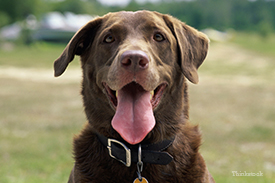 Answer: D. Dogs cannot dissipate (release) heat through sweat glands on the underside of their abdomen.
Answer: D. Dogs cannot dissipate (release) heat through sweat glands on the underside of their abdomen.
The primary way dogs dissipate heat is via panting. There are sweat glands in the ears and on the undersides of the paws (none on the underside of the abdomen), but they have only a limited capacity to cool a dog down. [Learn more about dogs and sweat here.]
3. Which one of the following is not a common symptom of heat stroke?
A. Collapse
B. Heavy panting
C. Vomiting
D. Coughing
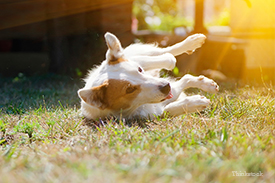 Answer: D. Coughing is not a common symptom of heat stroke.
Answer: D. Coughing is not a common symptom of heat stroke.
Symptoms of heat stroke can include heavy panting, weakness, uncoordinated gait, collapse, darker than normal appearing tongue and gums, vomiting, diarrhea, loss of consciousness, and seizures.
4. Which of the following statements is true?
A. Most dogs will regulate their activity level so as to prevent heat stroke.
B. Adequate water intake will help prevent heat stroke.
C. Most dogs fully recover from heat stroke if they receive aggressive veterinary care.
D. Heat stroke can occur on a cool day.
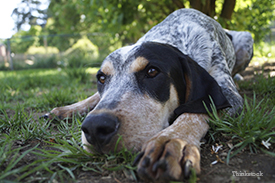 Answer: D. heat stroke can occur on a cool day.
Answer: D. heat stroke can occur on a cool day.
Believe it or not, with excess exertion, heat stroke can occur even on a cool day. Think of the tennis ball-addicted dog who keeps on fetching as long as someone keeps on throwing. Drinking lots of water helps, but won’t prevent heat stroke for dogs who work too hard in the heat. The unfortunate fact of the matter is that, even with aggressive veterinary care, many dogs with heat stroke fail to recover. Death is associated with blood clotting abnormalities, neurological damage, and/or organ failure. [Learn about safe running with your dog.]
5. Which of the following characteristics will not impact a dog’s predisposition to heat stroke?
A. The shape of the dog’s face
B. The length of the dog’s ears
C. The dog’s body condition score (indicates whether a dog is too thin, too fat, or just right)
D. The dog’s age
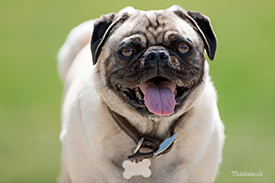 Answer: B. The length the ears will not impact a dog’s predisposition to heat stroke.
Answer: B. The length the ears will not impact a dog’s predisposition to heat stroke.
Smoosh-faced dogs such as Pugs, Bulldogs and Boston Terriers are super-challenged in the heat. These brachycephalic (short-headed) breeds cannot move air effectively enough through their tiny airways to adequately dissipate body heat.
Additionally, the exertion necessary for them to breathe heavily, even in normal conditions, can elevate their body temperature. Overweight dogs and older dogs are more prone to heat stroke. There is no known correlation between ear length and susceptibility to heat stroke. [Learn more about brachycephalic dogs.]
6. Which answer is true?
A. It is okay to leave your dog in your car on a hot day as long as the windows are rolled down all the way.
B. It is okay to leave your dog in your car on a hot day as longs as he has access to plenty of water.
C. It is okay to leave your dog in a car on a hot day as long as the time does not exceed ten minutes.
D. It is never okay to leave your dog in a car on a hot day.
 Answer: D. It is never okay to leave your dog in a car on a hot day.
Answer: D. It is never okay to leave your dog in a car on a hot day.
Every year, some folks convince themselves that it’s okay to leave the dog in the car on a hot day because, “I’m only going to pop into the store for just a few minutes,” or, “I’ll park in the shade.” Nope! Plainly and simply put, it is never okay to leave a dog (or any other living creature) in the car on a hot day. Some people want to get around this by leaving their dog in the car with the engine and air conditioning running. If you ask me, this is risky business.
7. Which disease predisposes a dog to heat stroke?
A. Laryngeal paralysis (dysfunction of the opening to the windpipe)
B. Heartworm disease
C. Kidney disease
D. All of the above
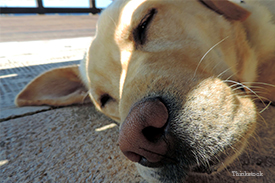 Answer: D. Laryngeal paralysis, heartworm disease, and kidney disease can all predispose a dog to heat stroke.
Answer: D. Laryngeal paralysis, heartworm disease, and kidney disease can all predispose a dog to heat stroke.
A dog’s ability to get rid of excess body heat relies on normal blood circulation. Dogs with kidney failure often operate in a mildly dehydrated state that dampens normal blood circulation. Heartworm disease poses a double whammy. Secondary heart changes can reduce blood circulation, and, if the lungs are affected, the dog’s ability to dissipate heat via panting may be reduced. Laryngeal paralysis refers to immobilization of the cartilage structures that control airflow from the mouth and nose into the windpipe. This disease interferes with the normal panting process.
8. On a hot day it is best to:
A. Exercise your dog early in the morning or during evening hours.
B. Leave your dog in your air conditioned home rather than taking him with you in your car to run errands.
C. Go swimming and eat lots of ice cream.
D. All of the above!
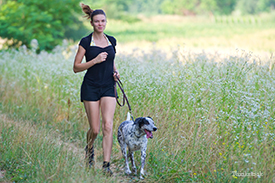 Answer: D. On a hot day it is best to exercise your dog early in the morning or during evening hours, leave your dog in your air conditioned home rather than taking him with you in your car to run errands, go swimming, and eat lots of ice cream!
Answer: D. On a hot day it is best to exercise your dog early in the morning or during evening hours, leave your dog in your air conditioned home rather than taking him with you in your car to run errands, go swimming, and eat lots of ice cream!
[Editor's Note: The ice cream is for you, not your dog. Learn about safe and cool dog treats here.]
Thanks for playing along! How did you do? What is your strategy if you see a dog locked in a car on a hot day?
Next, try a kidney disease quiz!
If you have any questions or concerns, you should always visit or call your veterinarian -- they are your best resource to ensure the health and well-being of your pets.
